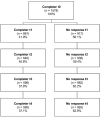COVID-19-Related Trajectories of Psychological Health of Acute Care Healthcare Professionals: A 12-Month Longitudinal Observational Study
- PMID: 35846720
- PMCID: PMC9280365
- DOI: 10.3389/fpsyg.2022.900303
COVID-19-Related Trajectories of Psychological Health of Acute Care Healthcare Professionals: A 12-Month Longitudinal Observational Study
Erratum in
-
Erratum: COVID-19-Related trajectories of psychological health of acute care healthcare professionals: A 12-month longitudinal observational study.Front Psychol. 2023 Mar 17;14:1180634. doi: 10.3389/fpsyg.2023.1180634. eCollection 2023. Front Psychol. 2023. PMID: 37008870 Free PMC article.
Abstract
The COVID-19 pandemic hit healthcare professionals (HCPs) hard, potentially leading to mental health deterioration. This longitudinal study investigated the 1-year evolution of psychological health of acute care HCPs during the COVID-19 pandemic and explored possible differences between high and low resilient HCPs. From April 2020 to April 2021, a convenience sample of 520 multinational HCPs completed an online survey every 3 months, up to five times. We used mixed linear models to examine the association between resilience and the variation of COVID-19-related anxiety, depressiveness, perceived vulnerability, and psychological trauma symptomatology. We demonstrated "u-shaped" trajectories for all mental health symptoms. We also explored differences in the abovementioned variables between front-line and second-line acute care HCPs. In contrast to HCP.s with lower levels of resilience (-1SD), those with higher levels of resilience (+1SD) showed increased COVID-19 anxiety and perceived vulnerability over time. Front-line and second-line HCPs differed in their depressiveness and psychological trauma variation during the 1-year analysis. High and average resilient second-line HCPs showed steeper depressiveness increases with time than high and average resilient front-line HCPs. Acute care HCPs reported their most elevated clinical symptoms of depressiveness (5-7%) and psychological trauma symptomatology (26-46%) in April 2020. During the first year of the COVID-19 pandemic, second-line HCPs with more resilience showed a steeper worsening of their depressiveness than more resilient front-line HCPs. HCPs with low resilience may benefit from interventions at the beginning of a pandemic, whereas HCPs with high resilience might benefit from resilience-enhancing interventions at later phases.
Trial registration: The study protocol was pre-registered with the International Standard Randomised Controlled Trial Number (ISRCTN13694948) published (Fuchs et al., 2020).
Keywords: COVID-19; acute care; healthcare workers; mental health; psychological resilience.
Copyright © 2022 Abegglen, Greif, Fuchs and Berger-Estilita.
Conflict of interest statement
The authors declare that the research was conducted in the absence of any commercial or financial relationships that could be construed as a potential conflict of interest.
Figures


Similar articles
-
Health-Promoting Quality of Life at Work during the COVID-19 Pandemic: A 12-Month Longitudinal Study on the Work-Related Sense of Coherence in Acute Care Healthcare Professionals.Int J Environ Res Public Health. 2022 May 16;19(10):6053. doi: 10.3390/ijerph19106053. Int J Environ Res Public Health. 2022. PMID: 35627590 Free PMC article.
-
Distress and resilience of healthcare professionals during the COVID-19 pandemic (DARVID): study protocol for a mixed-methods research project.BMJ Open. 2020 Jul 31;10(7):e039832. doi: 10.1136/bmjopen-2020-039832. BMJ Open. 2020. PMID: 32737101 Free PMC article.
-
Effects of the COVID-19 Pandemic on the Mental Health of Healthcare Providers: A Comparison of a Psychiatric Hospital and a General Hospital.Front Psychiatry. 2022 Jan 14;12:720693. doi: 10.3389/fpsyt.2021.720693. eCollection 2021. Front Psychiatry. 2022. PMID: 35095584 Free PMC article.
-
Oncology Healthcare Professionals' Mental Health during the COVID-19 Pandemic.Curr Oncol. 2022 Jun 2;29(6):4054-4067. doi: 10.3390/curroncol29060323. Curr Oncol. 2022. PMID: 35735432 Free PMC article. Review.
-
Healthcare worker resilience during the COVID-19 pandemic: An integrative review.J Nurs Manag. 2021 Nov;29(8):2329-2342. doi: 10.1111/jonm.13395. Epub 2021 Jul 9. J Nurs Manag. 2021. PMID: 34182609 Free PMC article. Review.
Cited by
-
Impact of Burnout on Anaesthesiologists.Turk J Anaesthesiol Reanim. 2024 May 3;52(2):54-59. doi: 10.4274/TJAR.2024.241565. Turk J Anaesthesiol Reanim. 2024. PMID: 38700106 Free PMC article.
-
Mindfulness-Based Interventions for Mental Health Outcomes in Frontline Healthcare Workers During the COVID-19 Pandemic: A Randomized Controlled Trial.J Gen Intern Med. 2025 May 19. doi: 10.1007/s11606-025-09529-z. Online ahead of print. J Gen Intern Med. 2025. PMID: 40388083
-
Mental Health of Healthcare Professionals: Two Years of the COVID-19 Pandemic in Portugal.Int J Environ Res Public Health. 2023 Feb 10;20(4):3131. doi: 10.3390/ijerph20043131. Int J Environ Res Public Health. 2023. PMID: 36833822 Free PMC article.
-
Counseling and support services for healthcare workers in German university hospitals during the pandemic-descriptive results of a Germany-wide cross-sectional survey.Front Public Health. 2023 Aug 10;11:1186929. doi: 10.3389/fpubh.2023.1186929. eCollection 2023. Front Public Health. 2023. PMID: 37637807 Free PMC article.
-
Trajectories of symptoms of depression, distress, and resilience in healthcare workers during the COVID-19 pandemic and toward its end in Czechia.Eur Psychiatry. 2024 May 13;67(1):e49. doi: 10.1192/j.eurpsy.2024.1752. Eur Psychiatry. 2024. PMID: 38738525 Free PMC article.
References
-
- Bendau A., Plag J., Kunas S., Wyka S., Strohle A., Petzold M. B. (2021). Longitudinal changes in anxiety and psychological distress, and associated risk and protective factors during the first three months of the COVID-19 pandemic in Germany. Brain Behav. 11:e01964. 10.1002/brb3.1964 - DOI - PMC - PubMed
-
- Berger-Estilita J., Abegglen S., Hornburg N., Greif R., Fuchs A. (2022). Health-Promoting Quality of Life at Work during the COVID-19 Pandemic: a 12-Month Longitudinal Study on the Work-Related Sense of Coherence in Acute Care Healthcare Professionals. Internat. J. Env. Res. Public Health 19:6053. 10.3390/ijerph19106053 - DOI - PMC - PubMed
LinkOut - more resources
Full Text Sources
Miscellaneous

